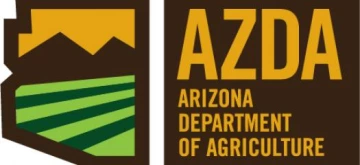< Back to Climate Viticulture Newsletter
Hello, everyone!
This is the November 2024 issue of the Climate Viticulture Newsletter – a quick look at some timely climate topics relevant to wine grape growing in Arizona.
IN THIS ISSUE
- A Recap of October Temperature and Precipitation
- The Outlook for November Temperature and Precipitation
- A Review of 2024 Ripening Conditions in Arizona AVAs
- Extra Notes
A Recap of October Temperature and Precipitation
Monthly average temperatures were more than 5 °F above the 1991-2020 normal for almost all of Arizona (dark orange areas on map). For reference, monthly average temperatures in October last year were 1 to 4 °F above normal for almost all of the state, with several locations in the central and southeastern parts recording values more than 4 °F above normal.
Area-average maximum and minimum temperatures during October 2024 were 85.6 and 53.6 °F for the Sonoita AVA, 89.0 and 51.9 °F for the Verde Valley AVA, and 87.7 and 48.8 °F for the Willcox AVA. Respective October normals are 77.3 and 47.5 °F, 80.2 and 47.0 °F, and 79.9 and 46.8 °F.
Temperature last month ranged between 95.4 and 29.1 °F at the AZMet Bonita station and between 96.4 and 28.8 °F at the AZMet Willcox Bench station.
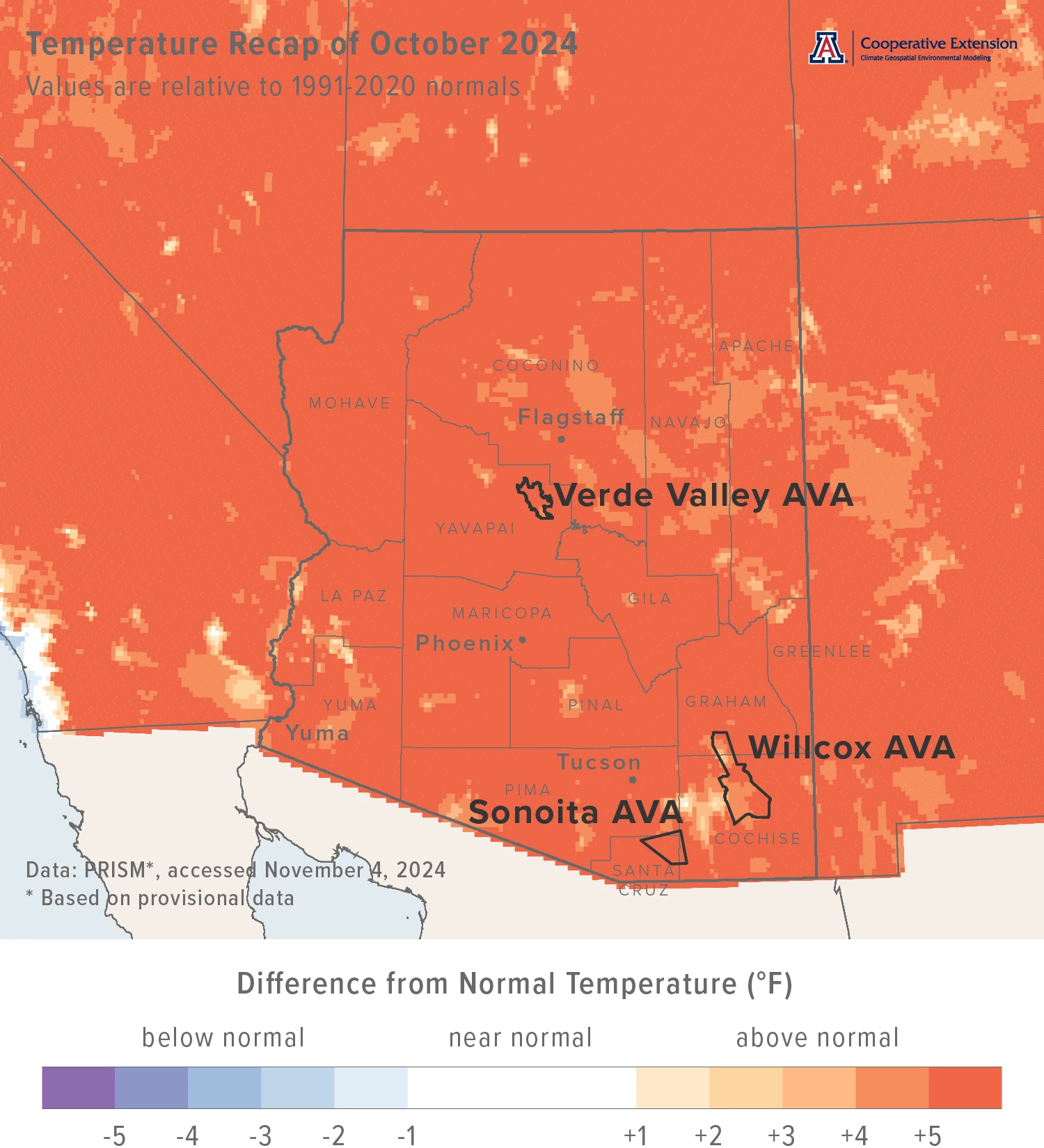
Jeremy Weiss
Monthly precipitation totals were less than 50 % of normal for much of the western one-third and southern two-thirds of the state (yellow and dark yellow areas on map), including all three Arizona AVAs. Only locations in northwestern Arizona recorded near- or above-normal totals (white, various aqua, and various blue areas on map). Precipitation during October 2023 was less than 25 % of normal for almost all of Arizona, with only some locations in the northeastern and southeastern parts of the state recording amounts between 25 and 75 % of normal.
Area-average total precipitation in October 2024 was 0.00 inches for the Sonoita AVA, 0.37 inches for the Verde Valley AVA, and 0.02 inches for the Willcox AVA. Respective October normals are 0.95, 1.05, and 0.76 inches.
Total precipitation last month was 0.00 and 0.20 inches at the AZMet Bonita and Willcox Bench stations, respectively.
Dig further into daily weather summaries for the AZMet Bonita and Willcox Bench stations in the Willcox AVA
Learn more about PRISM climate data
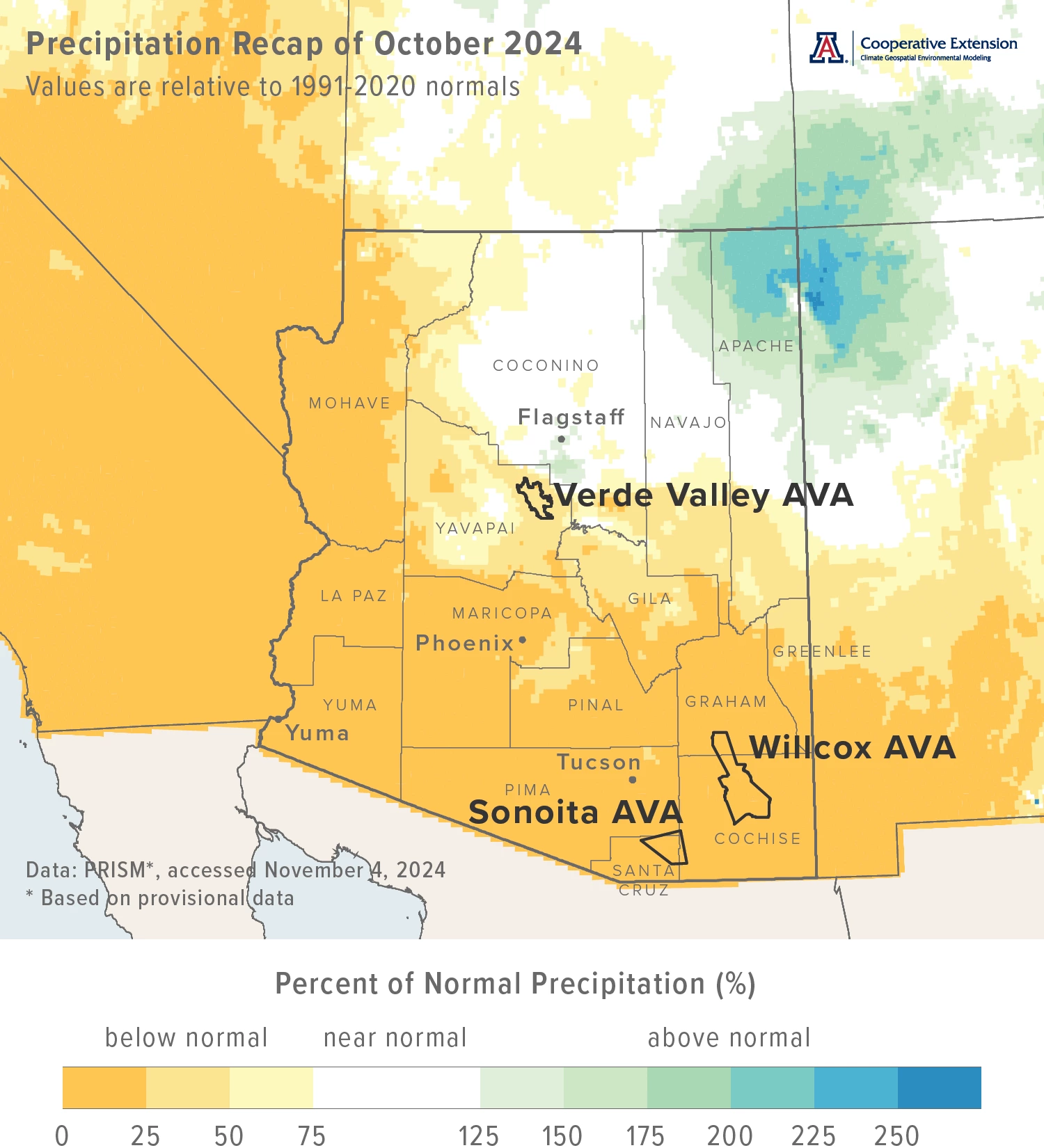
Jeremy Weiss
The Outlook for November Temperature and Precipitation
Temperatures over the course of this month have equal chances for being below, near, or above the 1991-2020 normal across all of the state (white area on map). Monthly average temperatures in November last year were 1 to 4 °F above normal for much of Arizona. Some locations in the central part of the state recorded values more than 4 °F above normal.
Area-average maximum and minimum temperatures during November 2023 were 68.7 and 40.4 °F for the Sonoita AVA, 70.3 and 37.9 °F for the Verde Valley AVA, and 70.2 and 38.5 °F for the Willcox AVA. Respective November normals are 67.2 and 38.2 °F, 67.5 and 36.6 °F, and 68.6 and 36.7 °F.
Temperature in November last year ranged between 85.5 and 27.5 °F at the AZMet Bonita station and between 86.9 and 26.2 °F at the AZMet Willcox Bench station.
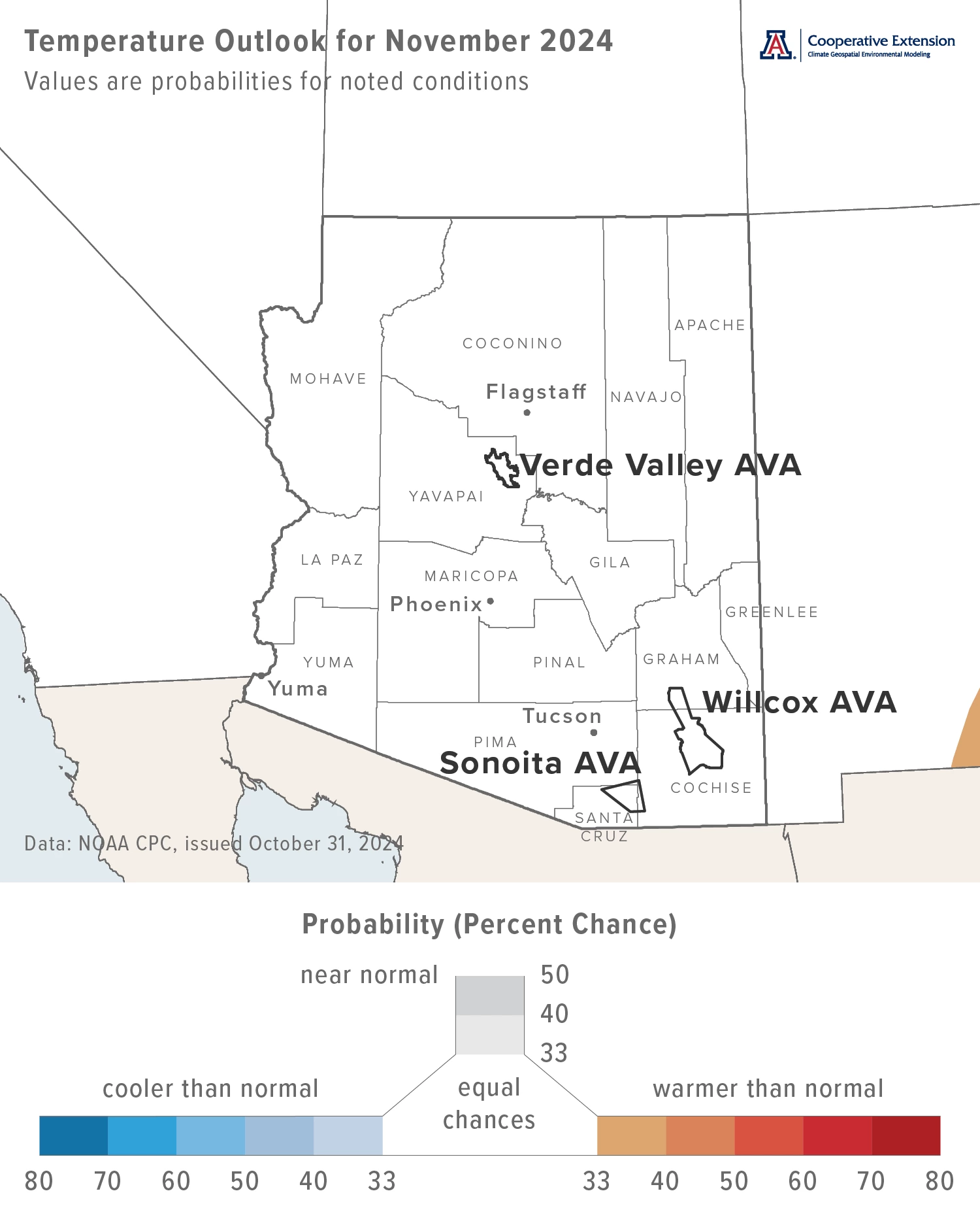
Jeremy Weiss
Precipitation totals this month have equal chances for being below, near, or above normal across all of Arizona (white area on map). Precipitation during November 2023 was less than 50 % of normal for much of the northwestern and southeastern parts of the state. Many locations in southwestern and northeastern Arizona recorded near-normal amounts, with some in the latter area measuring totals 125 to 175 % of normal.
Area-average precipitation totals in November 2023 were 0.07 inches for the Sonoita AVA, 0.42 inches for the Verde Valley AVA, and 0.15 inches for the Willcox AVA. Respective November normals are 0.84, 0.83, and 0.73 inches.
Total precipitation in November last year was 0.09 and 0.15 inches at the AZMet Bonita and Willcox Bench stations, respectively.
To stay informed of long-range temperature and precipitation possibilities beyond the coverage of a standard weather forecast, check in, too, with the six-to-ten-day outlook and eight-to-fourteen-day outlook issued daily by NOAA’s Climate Prediction Center.
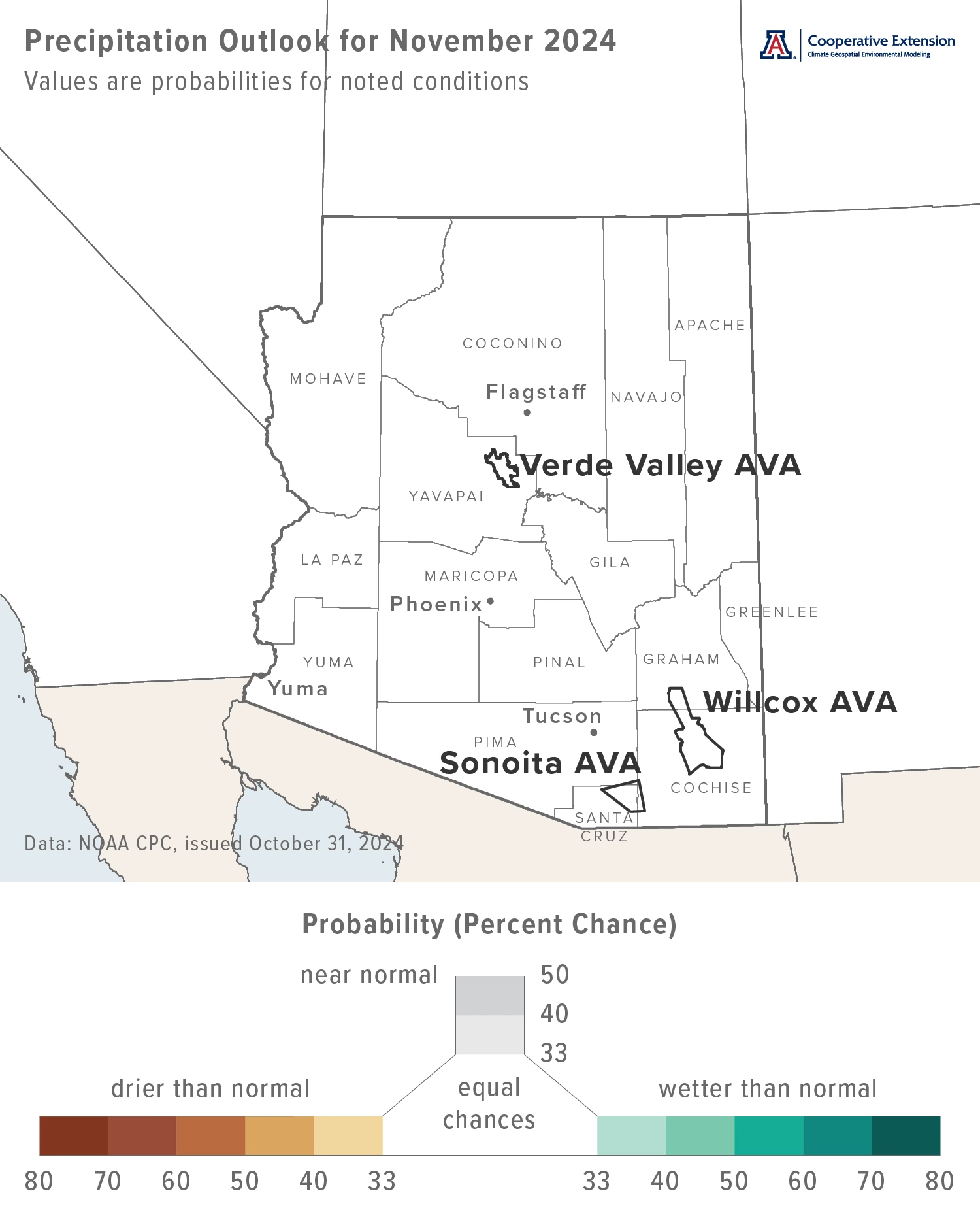
Jeremy Weiss
A Review of 2024 Ripening Conditions in Arizona AVAs
For the past few issues, we’ve taken a few different looks at the conditions under which wine grapes ripen. In August and September, the focus was on exposure to maximum temperatures above 95 °F and minimum temperatures below 65 °F. Last month, it was a double header with the first on the connection between dew point and diurnal temperature range and the second on when temperatures at this part of the growing season are more likely to cross relevant thresholds. Why all the attention? Because temperature, precipitation, and humidity affect fruit quality and composition.
This month, we continue to characterize ripening conditions from another angle. The focus remains on the months of July, August, and September, when most varieties ripen in most locations during most years. The analysis, however, zooms out from the daily details appearing in previous issues and summarizes seasonal temperature and precipitation from this year in comparison to prior ones.
Relative to recent vintages, ripening conditions in 2024 are like those in 2020 and 2023 for all three Arizona AVAs. This means that they are among the hottest and driest over the past four-plus decades. Data in these graphs go back to 1981.
Like 2020 and 2023, conditions this year essentially made the Sonoita AVA more like the Willcox AVA during an average year (green non-transparent point among purple semi-transparent points in top and bottom graphs), made the Willcox AVA more like the Verde Valley AVA during an average year (purple non-transparent point among orange semi-transparent points in top and bottom graphs), and placed the Verde Valley AVA at ends of its historical range. This may not be a meaningless statement, as conditions corresponding to the three AVAs tend to stratify, more so with maximum temperature and precipitation (orange, purple, and green points in top graph) than minimum temperature and precipitation (orange, purple, and green points in bottom graph). That is, the Verde Valley AVA generally is warmer and drier than the Willcox AVA, which generally is warmer and drier than the Sonoita AVA.
To the extent that temperature and precipitation affect fruit composition, we would expect conditions in 2024 to result in composition values that are relatively more distinguishable among the state AVAs for a given variety, as compared to values in 2023. Whether it is maximum temperature and precipitation (top graph) or minimum temperature and precipitation (bottom graph), points for the current vintage do not cluster as near to one another as they do for the vintage last year. In other words, ripening conditions in 2024 are not as similar for the three AVAs as they are in 2023.
Although we’ve written about this before, it bears repeating that the sequence of ripening conditions over the past five vintages could qualify as ‘weather whiplash’, a phrase used to describe a quick change from one set of extremes to an opposite set, particularly for the Sonoita and Willcox AVAs. Regardless of such conceptualization, this volatility is in line with the expectation for a more variable and extreme summer climate both now and in the coming years. For Arizona viticulture, performance of varieties during these vintages may suggest what their role might be in monsoon hedging and be an indication of their future viability.
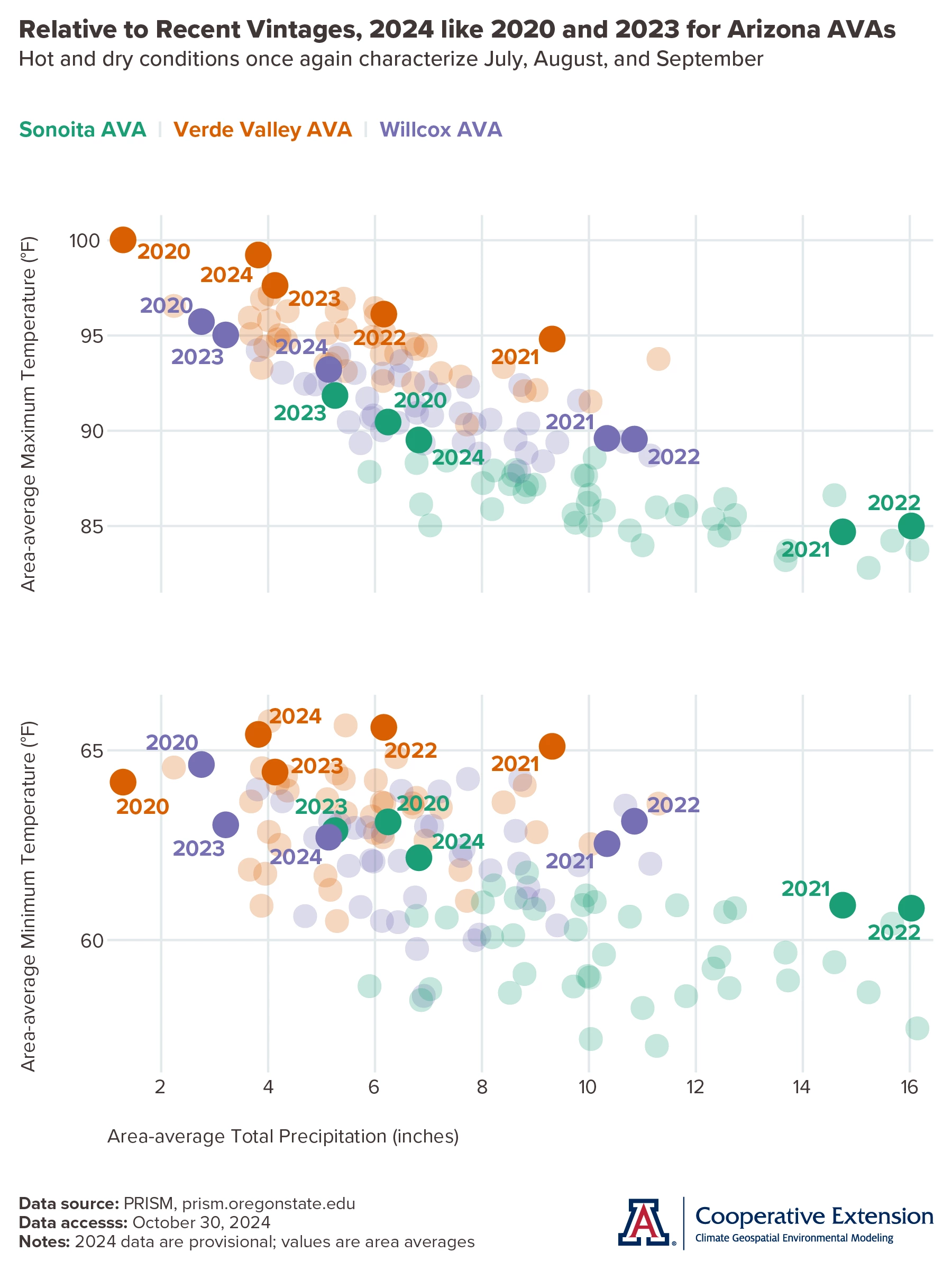
Jeremy Weiss
Extra Notes
The next viticulture symposium presented by Cooperative Extension will be December 4, 2024 at the University of Arizona Controlled Environment Agriculture Center in Tucson. Topics will include soils and fertility, integrative pest management, pathology, weather and climate, and the industry’s impact on tourism. Continuing education credits will be offered for licensed applicators. In addition, the Arizona Wine Growers Association will sponsor lunch and there will be a ‘Growing Season in Review’ workshop. Registration is $20 and required, as space is limited to 55 attendees. Please contact Matt Halldorson with any questions.
Odds declined to 60 % for La Niña conditions develop during the September-through-November period, with the expectation that they persist through the January-through-March period. This forecast also indicates a weak La Niña event of short duration, which implies that the typical below-normal totals of seasonal precipitation resulting from this ENSO phase may be less likely.
For those of you in southeastern Arizona, including the Sonoita and Willcox AVAs, Cooperative Extension manages an email listserv in coordination with the Tucson forecast office of the National Weather Service to provide information in the days leading up to agriculturally important events, like fall freezes and the occasional storm. Please contact us if you'd like to sign up.
And for those of you in north-central and northeastern Arizona, including the Verde Valley AVA, Cooperative Extension also now manages an email listserv in coordination with the Flagstaff forecast office of the National Weather Service to provide similar information for this part of the state. Please contact us if you'd like to sign up.
Undergraduate students in the College of Agriculture and Life Sciences at the University of Arizona are looking for internships with businesses and companies in the viticulture and winery industries. Please contact Danielle Buhrow, Senior Academic Advisor and Graduate Program Coordinator in the Department of Agricultural and Resource Economics, for more information.
Please feel free to give us feedback on this issue of the Climate Viticulture Newsletter, suggestions on what to include more or less often, and ideas for new topics.
Did someone forward you this newsletter? Please contact us to subscribe.
Have a wonderful November!
With current and past support from:
